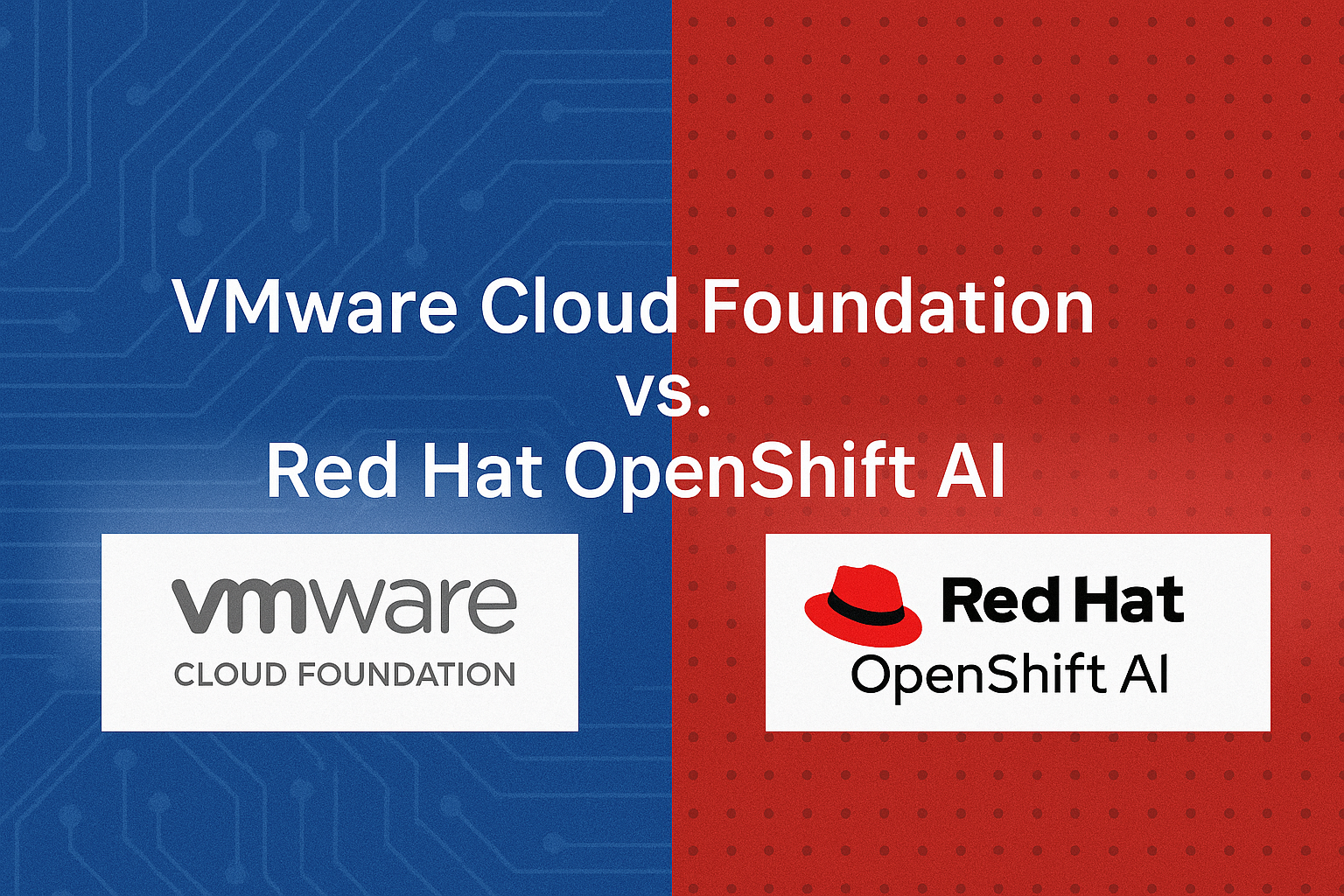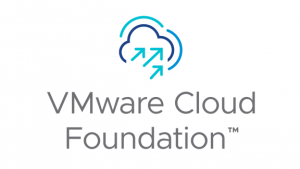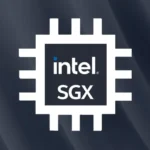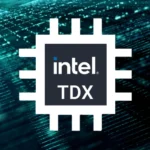VMware Cloud Foundation vs. Red Hat OpenShift AI: Which Platform is Right for Your AI Workloads?

As AI workloads become increasingly central to business innovation, organizations are turning to modern infrastructure platforms that can scale AI training and inference reliably, securely, and efficiently. Two leading options in this space—VMware Cloud Foundation and Red Hat OpenShift AI—offer enterprise-grade solutions, but with very different philosophies and strengths.
In this blog, we’ll explore the differences between these two platforms for deploying AI workloads, evaluate their supported technologies, and assess their pros and cons—especially around data privacy, security, and confidential computing.
What Is VMware Cloud Foundation?

VMware Cloud Foundation (VCF) is an integrated software platform that combines vSphere (compute), vSAN (storage), NSX (networking), and SDDC Manager (lifecycle management). AI workloads are supported using GPU virtualization (NVIDIA vGPU), Intel AMX and Gaudi, and DPUs. With deep partnerships with Intel and NVIDIA, VCF enables secure and performant infrastructure for AI—from private cloud to hybrid multi-cloud.
Key AI Technologies Supported on VCF:
- NVIDIA vGPU with MIG support
- Intel® AMX for CPU-based acceleration and Gaudi for GPU Acceleration
- VMware Tanzu (Kubernetes for AI workloads)
- Bitfusion (GPU dis-aggregation)
- Support for TensorFlow, PyTorch, Hugging Face, ONNX, etc.
- vSphere DRS for GPU-aware workload placement
What Is Red Hat OpenShift AI?

Red Hat OpenShift AI is built on OpenShift, Red Hat’s enterprise Kubernetes platform. It supports the end-to-end AI/ML lifecycle with open-source tools and Kubernetes-native practices, enabling data scientists and ML engineers to build, train, serve, and monitor models in a secure, collaborative environment.
Importantly, OpenShift can also be deployed directly on VMware vSphere infrastructure—allowing enterprises to combine OpenShift’s cloud-native AI tool-chain with the mature operational model of VMware.
Key AI Technologies Supported on OpenShift AI:
- OpenShift Kubernetes with GPU Operator support
- JupyterHub for notebook-based dev environments
- KServe for model serving and auto-scaling
- Kubeflow, MLflow, Ray for MLOps pipelines
- Intel OpenVINO, oneAPI integration
- Hugging Face, PyTorch, TensorFlow
- VMware vSphere as a supported infrastructure provider
🛡️ Confidential Computing: SGX and TDX
AI workloads increasingly process sensitive data—think healthcare, finance, defense, and customer behavioral data. Traditional encryption protects data at rest and in transit, but confidential computing ensures data is also protected while in use, during training or inference.
🔐 Intel SGX (Software Guard Extensions)

- Application-level protection via secure enclaves
- Fine-grained control but requires application modification
- Best for highly sensitive inference (e.g., federated learning)
🔐 Intel TDX (Trust Domain Extensions)

- VM-level isolation without needing app changes
- Enables confidential VMs for training and inference
- Ideal for multi-tenant environments or regulated sectors
VCF + Confidential Compute
- Supports Intel TDX for confidential VMs in VCF 9 onwards
- SGX enclaves supported via custom VM configurations
- NSX provides micro-segmentation for confidential workloads
- Best suited for regulated industries and compliance-heavy deployments
OpenShift AI + Confidential Compute
- Supports Intel TDX on compatible hosts
- Uses Confidential Containers (CoCo) for Kubernetes-native security
- SGX support available via RuntimeClass or plugins
- Ideal for federated learning or collaborative AI environments
Key Difference: VCF supports production-grade confidential VMs via Intel TDX. OpenShift AI is advancing in Kubernetes-native isolation with CoCo for fine-grained control.
⚖️ Feature Comparison
| Feature | VMware Cloud Foundation | Red Hat OpenShift AI |
|---|---|---|
| Infrastructure Base | Virtualization-first (vSphere) | Kubernetes-native (can run on vSphere) |
| Container Support | Tanzu Kubernetes Grid | OpenShift-native containers |
| AI Lifecycle Support | VM-based or Tanzu workloads | Full MLOps pipeline built-in |
| GPU Support | NVIDIA vGPU | NVIDIA GPU Operator, MIG |
| CPU Acceleration | Intel AMX | Intel oneAPI, OpenVINO |
| Model Serving | Manual or via K8s ingress | KServe native serving |
| MLOps Tools | 3rd-party integration | Kubeflow, MLflow, Ray |
| Confidential Compute | TDX from VCF 9, SGX (via VMs) | Confidential Containers, TDX-ready |
| Data Sovereignty | VM + NSX + vTPM | RBAC, namespaces, SELinux |
| Security Model | FIPS, NSX micro-segmentation | SELinux, SCCs, Compliance Operator |
| Deployment Flexibility | On-prem, hybrid, public (VMware Cloud) | On-prem, cloud-native, or on vSphere |
✅ Pros and Cons
VMware Cloud Foundation
Pros:
- Robust virtualization stack for enterprises
- Confidential VMs via Intel TDX in VCF 9
- Excellent GPU management with Bitfusion
- Strong security and compliance features
Cons:
- Limited native MLOps support
- Less developer-friendly without Tanzu or OpenShift
- SGX support requires app modification
Red Hat OpenShift AI
Pros:
- Cloud-native MLOps built-in
- Confidential containers for multi-tenant use cases
- Open ecosystem and developer-first design
- Flexible deployment, including on VMware
Cons:
- Steep learning curve for traditional ops teams
- TDX and SGX support evolving by environment
- Less mature GPU sharing compared to VCF
🧠 Which One Should You Choose?
| Use Case | Recommended Platform |
|---|---|
| Already using VMware, extending to AI | VMware Cloud Foundation |
| Need cloud-native MLOps on VMware hardware | OpenShift AI on vSphere |
| Highly regulated, secure confidential compute | VCF with TDX |
| Federated learning, container-native inference | OpenShift AI with CoCo |
📝 Final Thoughts
As AI workloads increasingly intersect with data privacy, security, and regulation, the decision between VMware Cloud Foundation and Red Hat OpenShift AI comes down to architecture, developer velocity, and confidential computing needs.
- VCF provides a secure, VM-based platform ideal for regulated and legacy environments.
- OpenShift AI enables rapid iteration, cloud-native MLOps, and can run on VMware vSphere to offer the best of both worlds.
In hybrid and multi-cloud AI environments, consider a blended strategy—VCF for secure production inference, and OpenShift AI for agile development and training.
